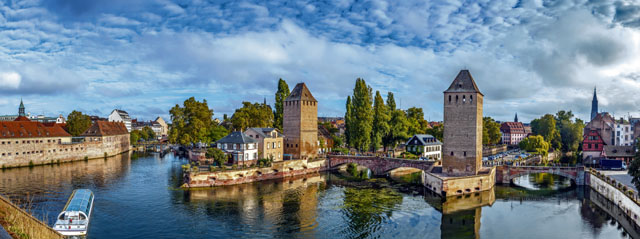
It’s perhaps the most unique city within a few hours driving distance from the Kaiserslautern Military Community but most people here have never driven south, crossed the Rhine near Baden-Baden and experienced Strasbourg, France. It’s without a doubt the nearest city to us with the most to offer.
Altogether historic, ancient, modern and stylish, the city has 250,000 people living on the inside perimeter but around 500,000 total if you include the outer edges. It’s not a metropolis by any means, but Strasbourg is in many ways comparable to the much larger Paris in that it has a certain sprawl to it that’s easy to navigate. If you tell a European native you are from Strasbourg or you’ve been to Strasbourg, they give you instant credibility for being in-the-know about what’s really good in this part of the world.
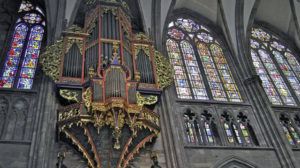 The main attraction of this fantastic city is the cathedral — building started in the 12th century — that looms large over the skyline. Strasbourg Muenster (Cathedral) was intended to have two spires but the second one was never finished. Made of a granite-like local pink Rose des Vosges sandstone, the church’s ornamental front entrance areas feature intricate sculptures of a variety of ancient biblical and period events. This is a fantastic zoom lens photo opportunity as you imagine master sculptors and builders hand crafting the building through the years.
The main attraction of this fantastic city is the cathedral — building started in the 12th century — that looms large over the skyline. Strasbourg Muenster (Cathedral) was intended to have two spires but the second one was never finished. Made of a granite-like local pink Rose des Vosges sandstone, the church’s ornamental front entrance areas feature intricate sculptures of a variety of ancient biblical and period events. This is a fantastic zoom lens photo opportunity as you imagine master sculptors and builders hand crafting the building through the years.
Strasbourg is indeed home to the NATO/EU Eurocorps creation and there is the popular astronomical clock that features a pay-to-watch chime event each day, but that sort of stuff is for sure worth skipping. Instead, take a look at the Strasbourg skyline from the top level of the cathedral or on the terrace at the Musée De L’Art Moderne, where you can sip a refreshment, eat a sandwich or salad, and just enjoy relaxing from the long strolls you are bound to take if you come here.
Walking is commonplace in Strasbourg where, like Amsterdam, nearly all the residents appear physically fit and in shape. Tramway is Strasbourg’s wonderful above ground train transport system, along with tons of city busses, and many VELHOP bicycles lined up on sidewalk racks, ready for rental. Walking thoroughfares and a city layout that is easy to navigate on foot make Strasbourg alluring for people of all ages. A 15-minute train ride will take you from downtown Strasbourg to the first German town on the route, Kehl, and there is a remarkable fluidity between the two countries that has always been visible in this fun-loving town.
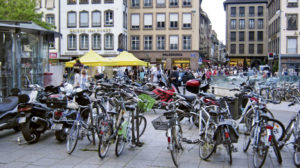 “Strasbourg and the Alsace area have been part of both Germany and France alternately through the years,” says Jeanne, a longtime resident and expert on the city. “There is a local dialect spoken here and people from both countries understand it. There is a marvelous restaurant, Aux Armes de Strasbourg, at Gutenberg Square, that is very Alsacian but also very German. There are paintings on the wall and interesting woodwork. They serve very good dishes that are representative of both countries and with a good balance between price and quality.”
“Strasbourg and the Alsace area have been part of both Germany and France alternately through the years,” says Jeanne, a longtime resident and expert on the city. “There is a local dialect spoken here and people from both countries understand it. There is a marvelous restaurant, Aux Armes de Strasbourg, at Gutenberg Square, that is very Alsacian but also very German. There are paintings on the wall and interesting woodwork. They serve very good dishes that are representative of both countries and with a good balance between price and quality.”
There are many restaurants scattered around Strasbourg that specialize in the Franco-German delicacy, Flammkuchen, which is pizza-like, with thin crust topped with ham or sausage and crème fraiche. It’s just as good as what you might find in Rothenburg and Munich or at a small festival in Landstuhl.
Another brilliantly-run restaurant is La Maison Kammerzell, which operates inside Strasbourg’s oldest dwelling, a hotel dating back to the 15th century. La Maison Kammerzell serves fish and pork dishes indigenous to the Alsace area and a variety of interesting desserts are served to top off these hearty meals.
A trip to Strasbourg will make you want to return for many more visits, as it is a place that American people love to take relatives who visit here. Driving south, down through Zweibruecken is the best way to see the backroads and it’s tempting to stop along the way and sample the culture that in one word could be described as ‘welcoming.’ There are places to buy jellies, jams, yard décor woodworking and birdhouses, or wine.
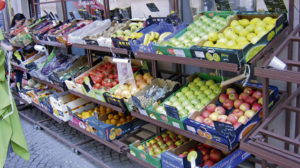 The wine industry is alive and well around Strasbourg. One romantic place we walked to for a nightcap was the splendidly run XX Wine bar, which had cheese samplings spread out on small boards and allowed us to unwind after a good meal elsewhere before heading back to tuck into our rental apartment beds.
The wine industry is alive and well around Strasbourg. One romantic place we walked to for a nightcap was the splendidly run XX Wine bar, which had cheese samplings spread out on small boards and allowed us to unwind after a good meal elsewhere before heading back to tuck into our rental apartment beds.
Wineries are situated in and around small towns, overlooked by the Vosges mountain range that covers much of the southern expanse below Strasbourg. Many of the wineries are between Colmar and Strasbourg, all within 15-20 minute drives by car or on board the many coaches and busses that shuttle people to these areas daily. There are tours of the cellars and facilities, complimentary tastings, items for sale, and lots of time at the end to do things back inside the city limits.
When shopping for typically-French items, people gravitate to two areas of the city close by one another and containing astounding indoor architecture. La Galleries de Lafayette and La Printemps are open daily and not the sorts of department stores you might find in American malls. Both can tend to be pricey but each contains authentic merchandise representing the Alsace area and France as a whole.
Keeping with the theme that Strasbourg itself is a walking town and flat enough to allow for long treks, the best area to walk and look is the La Petite France district. This part of town is Strasbourg as it was centuries ago. Most of the dwellings trace to the 15th, 16th and 17th centuries and sit along beautiful canals with shops, restaurants and a general pedestrian-friendly feel to the area. La Petite France is a splendid place to spend time during fall, when leaves are changing but the weather hasn’t gotten too cool. Different parts of La Petite France are reminiscent of Venice, Paris, Amsterdam and Bruges, keeping with the city’s seeming desire or quest to try and be all things to all people.
The city features one of Europe’s most modern train stations and airports. A website description of Strasbourg reads, “Europe is alive here – the Europe of democracy, the Europe which belongs to its citizens, is being constructed here to deal with the major issues currently facing our society, such as education, industrial modernization, solidarity, the change in energy sources and eco-responsibility,” as quoted on www.en.strasbourg.eu.
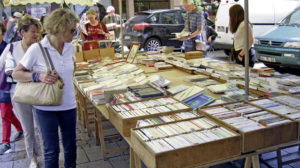 Those words offer the Strasbourgian mantra or theme, in a city that never ceases to flaunt its cultural diversity, with both strong roots to the past and a continuing push to stay on the cutting edge or what is current and what is still to come. See works by Rodin, Monet, or Picasso at the Museum of Modern Art, the many aged items showcased at the Musée Historique, stage performances or music concerts at L’Opera House, La Theatre National and La Maillon performing arts center, ballet and dance at the South Pole (Pole Sud), the annual Musica festival, and the venerable Museum de L’ouevre Notre Dame which holds artifacts discovered around the city’s famous cathedral.
Those words offer the Strasbourgian mantra or theme, in a city that never ceases to flaunt its cultural diversity, with both strong roots to the past and a continuing push to stay on the cutting edge or what is current and what is still to come. See works by Rodin, Monet, or Picasso at the Museum of Modern Art, the many aged items showcased at the Musée Historique, stage performances or music concerts at L’Opera House, La Theatre National and La Maillon performing arts center, ballet and dance at the South Pole (Pole Sud), the annual Musica festival, and the venerable Museum de L’ouevre Notre Dame which holds artifacts discovered around the city’s famous cathedral.
The biggest protestant church in Europe — St. Thomas — has a vibrant congregation and something going on all the time. St. Pierre Le Vieux is a joint catholic and protestant venture that also serves a wide community of theists. Pont Couverts (covered bridges) are sights to behold that date back to the construction of a protective wall in this 2000-year-old town. What’s not to like about Strasbourg? Take a trip there and see if you can figure it out for yourself.
Restaurant suggestions
“La Maison Kammerzell”
(Kammerzell House)
16 Place de la Cathédrale
(0033) 388 32 42 14
Fish, pork dishes
“L’Ancienne Douane”
(Old Customs)
6 Rue de la Douane
(0033) 388 15 78 78
Variety of traditional and new foods
“La Corde à Linge”
(Clothesline)
2 Place Benjamin Zix
(0033) 388 22 15 17
Samplings from nearby areas
“Aux Armes de Strasbourg”
(The Weapons of Strasbourg)
9 Place Gutenberg
(0033) 388 32 85 62
Alsace and German traditional
“La Hache”
(The Ax)
11 Rue de la Douane
(0033) 388 32 34 32
Steak and meat items


